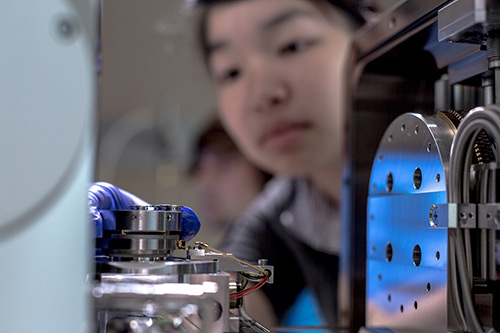
 Researchers at UC Merced are making a big deal out of a piece of equipment that lets them look at really tiny things. And they should — the new Zeiss Gemini SEM 500 scanning electron microscope is the first of its kind installed in the United States.
Researchers at UC Merced are making a big deal out of a piece of equipment that lets them look at really tiny things. And they should — the new Zeiss Gemini SEM 500 scanning electron microscope is the first of its kind installed in the United States.
“It’s the latest model in Zeiss’ well-established platform,” School of Engineering Professor Anand Subramaniam said. “This is an essential element of nanotechnology research, but it’s also important for our campus to have this kind of equipment, because it helps us teach and prepare students.”
The microscope is housed in the campus’s Imaging and Microscopy Facility (IMF), a core research facility operated by the Office of Research and Economic Development. It was purchased through the NASA-funded Merced Nanomaterials Center for Energy and Sensing (MACES).
MACES, established last year, is already expanding opportunities for researchers across campus and for students throughout the San Joaquin Valley.
Thanks to Chancellor Dorothy Leland and Vice Chancellor for Research and Economic Development Sam Traina, who supplemented NASA’s grant funds with $150,000, the new microscope is available for use by anyone on campus.
“It’s very, very high resolution,” said School of Engineering Professor Jennifer Lu, the MACES director. “With it, we can see nanometer-scale objects. This instrument enables us to conduct enhanced nanomaterial-based research.”
To put that in perspective, a sheet of paper is about 100,000 nanometers thick. A strand of human DNA is 2.5 nanometers in diameter. There are 25,400,000 nanometers in one inch. A human hair is approximately 80,000 to 100,000 nanometers wide.
The researchers are building tiny structures for biological sensing and green-energy harvesting and conversion, and they need to be able to get images of the structures they are creating. The new microscope will let them see nanoscale topography and orientation of nanoscale objects.
An electron beam scanned over samples reveals nanoscale features that could never be seen even with the highest-resolution light microscope. To ensure maximum performance, the new SEM is installed in a soundproofed, vibration-minimizing lab outfitted with special metal plates that keep the room as free of outside interference as possible.
“We had to put the lab where it is, because if it were closer to the outside of the building, even a large truck going by could pull the electron beam away from its target,” lab manager Mike Dunlap said.
While the new microscope features industry leading resolution, another reason MACES chose this model is because it is very user-friendly, the professors said. Novice students under the supervision of an intermediate user can get usable images with nanoscale resolution from certain types of samples within an hour, Subramaniam said.
The public will get its first chance to see the microscope at an open house co-hosted by MACES and Zeiss on July 14, Zeiss said. There will be other public events throughout the year as well, but researchers are already using the SEM with great results, Professor Tao Ye said.
While graduate students are the major users of this cutting-edge instrument, the SEM will also benefit undergraduate training and even professional development programs for high school teachers hosted by MACES.
The center is also shepherding a group of seven Merced College and California State University students for a two-month summer internship. Lu and other MACES-affiliated faculty members will mentor the students as they learn proper lab procedures and get hands-on experience in building nanomaterials, including using the new SEM.
The summer opportunities are part of MACES outreach efforts to increase the number of students who choose science, technology, engineering and math (STEM) paths with the goal of growing the Valley’s highly trained workforce.
“Through rigorous training, our goal is to prepare Ph.D. graduates who will evolve as major contributors to NASA’s mission,” Lu said. “We’re also promoting and cultivating research efforts between our faculty members and graduate and undergraduate students from UC Merced and beyond.”
Lorena Anderson

Senior Writer and Public Information Representative
Office: (209) 228-4406
Mobile: (209) 201-6255






